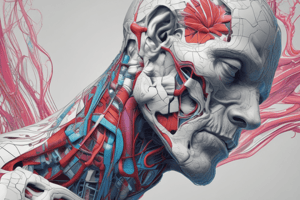Podcast
Questions and Answers
What is the most basic structural and functional unit of the body?
What is the most basic structural and functional unit of the body?
- Tissue
- Cell (correct)
- Organ
- Organ system
Which cavity contains the heart, lungs, and major blood vessels?
Which cavity contains the heart, lungs, and major blood vessels?
- Cranial cavity
- Abdominal cavity
- Pelvic cavity
- Thoracic cavity (correct)
What is the function of the circulatory system?
What is the function of the circulatory system?
- Brings oxygen into the body and removes carbon dioxide
- Produces hormones that regulate body functions
- Breaks down and absorbs nutrients from food
- Transports oxygen and nutrients to cells and removes waste products (correct)
What is the function of the mitochondria?
What is the function of the mitochondria?
What is the purpose of negative feedback mechanisms in the body?
What is the purpose of negative feedback mechanisms in the body?
What is the function of the golgi apparatus?
What is the function of the golgi apparatus?
What is the function of the skeletal system?
What is the function of the skeletal system?
What is the definition of homeostasis?
What is the definition of homeostasis?
Flashcards are hidden until you start studying
Study Notes
Organization of the Body
- The human body is composed of several levels of organization:
- Chemical level: atoms, molecules, and compounds
- Cellular level: cells, the basic structural and functional units of the body
- Tissue level: groups of similar cells that perform specific functions
- Organ level: structures composed of two or more types of tissues that perform specific functions
- Organ system level: groups of organs that work together to perform specific functions
- Organismal level: the entire human body
Body Cavities
- The body has several cavities that contain and protect internal organs:
- Cranial cavity: contains the brain
- Thoracic cavity: contains the heart, lungs, and major blood vessels
- Abdominal cavity: contains the digestive organs
- Pelvic cavity: contains the reproductive organs and urinary bladder
Body Systems
- The human body has several systems that work together to maintain homeostasis:
- Nervous system: controls and coordinates body functions
- Circulatory system: transports oxygen and nutrients to cells and removes waste products
- Respiratory system: brings oxygen into the body and removes carbon dioxide
- Digestive system: breaks down and absorbs nutrients from food
- Endocrine system: produces hormones that regulate body functions
- Immune system: protects the body against pathogens and disease
- Muscular system: provides movement and support
- Skeletal system: provides support and protection
- Integumentary system: protects the body from external damage and regulates body temperature
- Urinary system: filters waste and excess fluids from the blood
- Reproductive system: produces sex cells and supports the development of a fetus
Cellular Components
- Cell membrane: regulates what enters and leaves the cell
- Cytoplasm: jelly-like substance inside the cell membrane
- Nucleus: contains genetic material
- Mitochondria: generates energy for the cell
- Ribosomes: produces proteins
- Lysosomes: breaks down and recycles cellular waste
- Golgi apparatus: processes and packages proteins and lipids
- Cytoskeleton: provides structural support and shape to the cell
Homeostasis
- Homeostasis: the ability of the body to maintain a stable internal environment despite changes in the external environment
- Negative feedback mechanisms: help to maintain homeostasis by reversing changes in the body's internal environment
- Positive feedback mechanisms: amplify changes in the body's internal environment
Organization of the Body
- Human body composed of six levels of organization: chemical, cellular, tissue, organ, organ system, and organismal levels.
- Each level builds upon the previous one to form a hierarchical structure.
Body Cavities
- Four main body cavities: cranial, thoracic, abdominal, and pelvic cavities.
- Cranial cavity contains the brain, thoracic cavity contains heart, lungs, and major blood vessels, abdominal cavity contains digestive organs, and pelvic cavity contains reproductive organs and urinary bladder.
Body Systems
- Eleven major body systems: nervous, circulatory, respiratory, digestive, endocrine, immune, muscular, skeletal, integumentary, urinary, and reproductive systems.
- Nervous system controls and coordinates body functions, circulatory system transports oxygen and nutrients, respiratory system brings in oxygen and removes carbon dioxide, and so on.
Cellular Components
- Cell membrane regulates what enters and leaves the cell.
- Cytoplasm is a jelly-like substance inside the cell membrane.
- Nucleus contains genetic material, mitochondria generates energy, ribosomes produce proteins, and lysosomes break down cellular waste.
- Golgi apparatus processes and packages proteins and lipids, and cytoskeleton provides structural support and shape to the cell.
Homeostasis
- Homeostasis is the body's ability to maintain a stable internal environment despite external changes.
- Negative feedback mechanisms reverse changes in the body's internal environment to maintain homeostasis.
- Positive feedback mechanisms amplify changes in the body's internal environment, but are less common and usually related to specific events like childbirth.
Studying That Suits You
Use AI to generate personalized quizzes and flashcards to suit your learning preferences.




